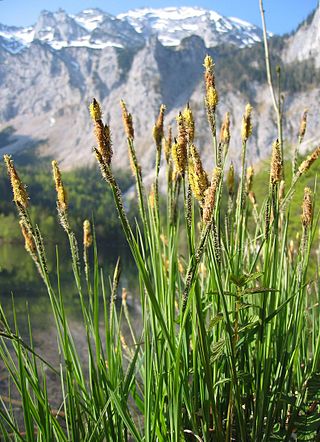
Aralia elata, also known as the Japanese angelica tree, Chinese angelica-tree, or Korean angelica-tree, is a species of woody plant in the family Araliaceae.

Yucca elata is a perennial plant, with common names that include soaptree, soaptree yucca, soapweed, and palmella. It is native to southwestern North America, in the Sonoran Desert and Chihuahuan Desert in the United States, southern Nevada, southwestern Utah, and northern Mexico. Yucca elata is widely distributed, although its population appears to be decreasing.

Psychotria is a genus of flowering plants in the family Rubiaceae. It contains 1,582 species and is therefore one of the largest genera of flowering plants. The genus has a pantropical distribution and members of the genus are small understorey trees in tropical forests. Some species are endangered or facing extinction due to deforestation, especially species of central Africa and the Pacific.

Pericopsis elata is a species of flowering plant in the family Fabaceae and is known by the common names African teak, afromosia, afrormosia, kokrodua and assamela.

Acacia elata the cedar wattle or mountain cedar wattle is a tree found in eastern Australia.

Morchella elata is a species of fungus in the family Morchellaceae. It is one of many related species commonly known as black morels, and until 2012 the name M. elata was broadly applied to black morels throughout the globe. Like most members of the genus, M. elata is a popular edible fungus and is sought by many mushroom hunters.
Vestia ranojevici is a species of air-breathing land snail, a terrestrial pulmonate gastropod mollusk in the family Clausiliidae, the door snails, all of which have a clausilium.

Roystonea regia, commonly known as the Cuban royal palm or Florida royal palm, is a species of palm native to Mexico, the Caribbean, Florida, and parts of Central America. A large and attractive palm, it has been planted throughout the tropics and subtropics as an ornamental tree. Although it is sometimes called R. elata, the conserved name R. regia is now the correct name for the species. The royal palm reaches heights from 15–24 m (50–80 ft) tall. Populations in Cuba and Florida were long seen as separate species, but are now considered a single species.

Dactylorhiza elata, the robust marsh orchid, is a species of flowering plant in the family Orchidaceae, native to the western Mediterranean region.

Dorstenia elata is a plant species in the family Moraceae.

Isoquercetin, isoquercitrin or isotrifoliin is a flavonoid, a type of chemical compound. It is the 3-O-glucoside of quercetin. Isoquercitrin can be isolated from various plant species including Mangifera indica (mango) and Rheum nobile. It is also present in the leaves of Annona squamosa, Camellia sinensis (tea). and Vestia foetida

Vestia is a genus of air-breathing land snails, terrestrial pulmonate gastropod mollusks in the family Clausiliidae, the door snails, all of which have a clausilium.

Vestia, formally Stichting Vestia is the largest public housing corporation in the Netherlands, which is headquartered in Rotterdam. The corporation owns about 78,000 houses and 8,000 other "rentable units".

Actaea elata is a species of flowering plant in the buttercup family known by the common name tall bugbane. It is native to the Pacific Northwest of North America, where it can be found in British Columbia, Washington, and Oregon.

Vestia is a monotypic genus of flowering plants in the family Solanaceae containing the single species Vestia foetida (syn. V. lycioides). Its principal common names in the Mapudungun language of its native Chile are Huevil (pron. "wayfil" and sometimes redoubled Huevilhuevil) and Chuplín. Other Chilean names include Chuplí, Echuelcún and Palqui (negro) (this last being also applied to Cestrum parqui), while an English common name Chilean box thorn has also been coined recently in reference to a certain similarity of the plant to some species in the box thorn / wolfberry genus Lycium (as referenced also in the former specific name lycioides, meaning "Lycium-like"). Vestia foetida is endemic to central and southern Chile, being found in an area stretching from the Valparaíso Region in the north to Chiloé Island (in the Los Lagos Region) in the south. Growing to 2 m (7 ft) tall by 1.5 m (5 ft) broad, it is an evergreen shrub with glossy, privet-like, mid-green leaves. In spring and summer it bears tubular yellow flowers to 3 cm (1 in) long, with stamens so markedly exserted (= protruding) as to recall those of certain Fuchsia species, followed by 4-valved, ovoid capsules to 1 cm (0 in), containing small, prismatic seeds.

Palicourea elata, formerly Psychotria elata, commonly known as girlfriend kiss and labios de puta, is a tropical plant that ranges from Central to South American rain forests in countries such as Mexico, Costa Rica, Ecuador, Panama, and Colombia. Palicourea elata is extremely sensitive and requires specific climates to grow, those climates most like rainforests are best suitable for this plant. It is most notable for its distinctly shaped red bracts and is consequently nicknamed “Hot Lips”. Though the bright red bracts are considered its most flashy feature, they are not the actual flowers of the plant but instead extravagant leaves; the flowers of Palicourea elata lie within the “red lip” leaves. Just like human lips, the hot lips plant comes in a variety of shapes and forms offering a vast array of plants. P. elata is well-studied and has been documented over centuries to provide various health benefits to native communities. Due to these benefits and the overall appearance of the plant, it has been over-harvested and is now endangered.

Carex elata, tufted sedge, is a species in the genus Carex, native to all of Europe, the Atlas Mountains of Africa, Turkey, Iran and Central Asia. It prefers to grow with its roots in water. Its cultivar 'Aurea' has gained the Royal Horticultural Society's Award of Garden Merit.
Vestia roschitzi is a species of air-breathing land snail within the family Clausiliidae,
















